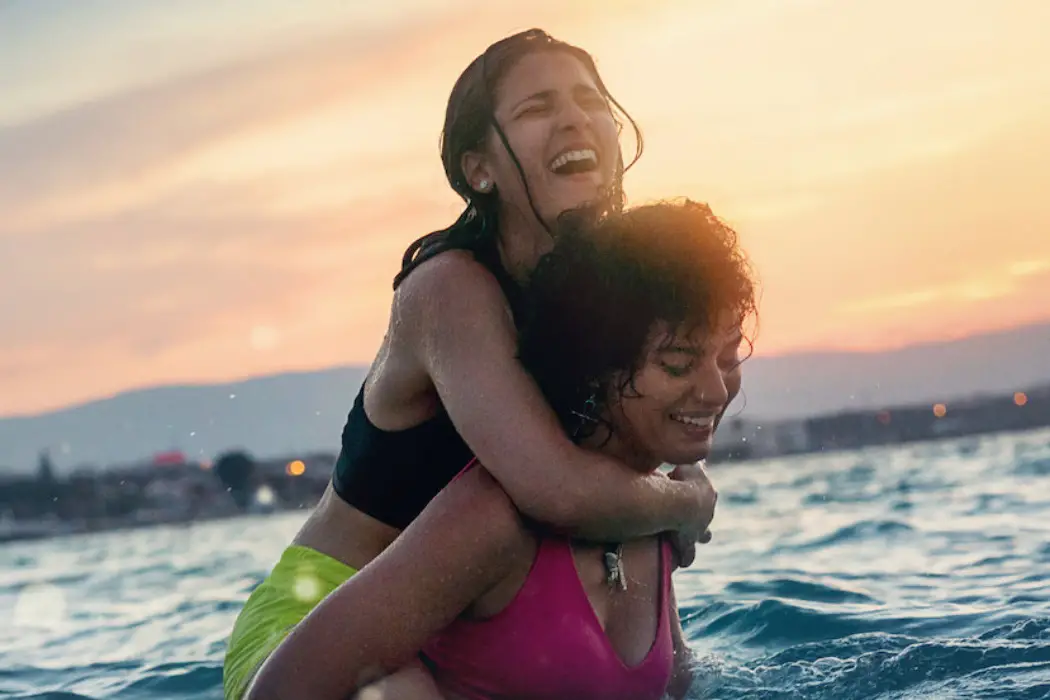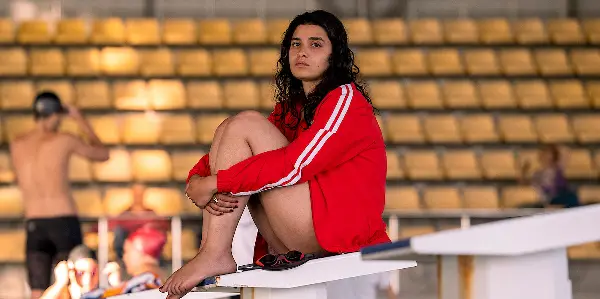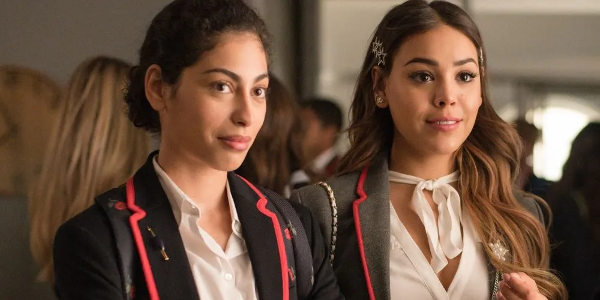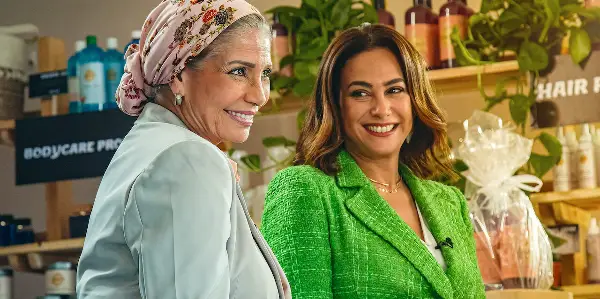Netflix’s Love Affair With Arab Women: A Double-Edged Sword

Amina is a twenty-four year old journalist living in Cairo,…
In November 2022, Netflix released Welsh-Egyptian director Sally El Hosseiny’s biographical drama, The Swimmers, on its platform. The film follows refugee sisters and athletes Yusra and Sara Mardini (real-life sisters Natalie and Manal Issa) on their journey from war-torn Syria to the 2016 Rio Olympics.
Like most people, I watched The Swimmers on my laptop screen in bed. I cried when the Mardini sisters jumped off the inflatable dinghy carrying a group of refugees across the Aegean sea. I sighed with relief when the characters reached the shores of Lesvos island in Greece. Like many Arab viewers, I cringed at the awkwardness of some of the English-language dialogue and the subtle orientalism underlying many interactions; but the truth is I thought very little of it.
While problematic, these elements seemed very much at home in a Netflix production: the same studio who brought us Elite’s seasonal hijabi, Nadia (Mina El Hammami); and The Bold Type’s “proud Muslim lesbian,” Adena (Nikohl Boosheri), whose hijab and sexual orientation were equally accessory.
I watched and forgot all about The Swimmers, until one of the film’s stars, Manal Issa, joined the chorus of voices pointing rightful critiques at the film. Her dissatisfaction with aspects of the script, representational politics, and the production process pushed me to revisit not only The Swimmers, but the bulk of Netflix’s recent endeavors into the Arab market — specifically, its ongoing love affair with Arab women.
Netflix championing Arab women
In 2022, Netflix broke new ground in its championship of Arab women. Last April, the streaming service announced its partnership with the Arab Fund for Arts and Culture, which is providing a one-time grant to five Arab women filmmakers through the Netflix Fund for Creative Equity.
Three months later, the streaming giant released a special collection of 21 films directed by women from eleven Arab countries as part of its Because She Created platform, encompassing experimental documentaries; short films; and independent productions which for the most part enjoyed limited viewership outside the festival circuit.

Launched in 2021 as a virtual panel discussion, Because She Created had its second edition at the Cairo International Film Festival last November. A month later, the platform flocked to Jeddah for the Red Sea International Film Festival, where Netflix hosted a creative space celebrating the achievements of pioneering Arab women filmmakers.
This championship extends to Netflix’s own original productions, though to more mitigated results. In recent years, Arab women characters have increasingly populated the glossy realm of Netflix shows, often prompting criticism —from Degrassi: Next Class‘s (2016) chronicling of Syrian refugee students’ coming-of-age at a Canadian high school, to Elite‘s (2018) clumsy depiction of Muslim girlhood.
The streaming service’s own Arab productions have also garnered mixed reviews. They include Tima Shomali’s 2021 hit show, Al Rawabi School for Girls, praised for its honest portrayal of Arab patriarchy; Finding Ola (2022), the whimsical sequel to a beloved 2010s comedy; and the more controversial paranormal teen drama, Jinn (2019), described by Karthik Shankar as being “so generic, it seems plausible that it was scripted by algorithms rather than humans.”
Ranging from the powerful to the caricaturesque, Netflix’s Arab women are nonetheless bound to a tight set of representational tropes. When they are not struggling refugees, these characters are almost exclusively affluent and English-speaking —or, in the case of The Swimmers, they are both. The Rawabi schoolgirls switch back and forth between languages, their cultural repertoires encompassing both Mashrou’ Leila and Zac Efron’s abs.
In the decade since audiences first met them on the Egyptian show I Want to Get Married, Finding Ola’s titular protagonist (Hend Sabry) and her mother (Sawsan Badr) have climbed a hefty few steps up the social ladder. In the Arab world, most Muslim women wear the veil. But in the Netflix cinematic universe, the few who do overwhelmingly treat the hijab as a decorative ornament.
While some may feel represented by these portrayals, they remain largely divorced from the lives of most women in the Arab world, strangely absent from Netflix’s 4K rendition of the region.

Arab women have grown used to Hollywood portraying us as helpless victims of barbaric patriarchs, hyper-sensual belly dancers, or co-conspirators in terrorist plots; but the above works seem to have cornered us into a shiny new box. Why, then, do Netflix’s Arab women so often fall short of meaningful representation – unlike the wealth of impactful films recently added to its catalog?
One could speculate endlessly about hidden agendas, but the fact is that Netflix’s raison d’être is not to revolutionize Arab women’s portrayals on screen, and Silicon Valley execs aren’t conspiring against us, either.
Why us? Why now?
Arab women have been at the forefront of the film industry for years, whether as creators or representational subjects. Their demands for more substantial and adequate representation are nothing new. Yet, Netflix’s adamant interest in this demographic is a fairly recent phenomenon, begging the question: why now? The answer lies in its data-driven curatorial processes.
Behind any creative decision is a financial incentive, best understood through Netflix’s business model. The service generates profit by acquiring new customers and turning them into paying subscribers. To do so, it must accurately determine what content these users want to stream: a process in which algorithms play an essential role.
The streaming giant makes no secret of its reliance on big data, well-documented on its Tech Blog and elsewhere. Its data collection processes, outlined in its privacy policy, encompass basic demographic information and more intricate detail, like date and time a user watched a show, which device was used, whether the show was paused, resumed after pausing, which scenes were replayed or skipped through, and how long it took a user to watch the show.
Based on this information, Netflix’s algorithm sorts members into its over 1300 taste groups, driving curation and promotional strategies, as reported by Variety magazine. It is also worth noting that Netflix’s taste groups and viewer targeting mechanisms are based on viewing behavior, rather than demographic backgrounds — this means that viewers in Europe or North America are likely to get recommendations for South Asian, Arab, or Turkish dramas, and vice versa.

This data also helps the service identify and cater to potential new customers. In parallel to its internal data collection, Netflix conducts market sizing and studies competition to determine what share of the market it can seize and build multiple “ideal customer profiles”. It also studies internet browsing behavior, social media trends, and piracy to better understand what kind of content customers are seeking and cannot access through other mainstream platforms.
Additionally, this data informs the creation of Netflix original productions: content which is exclusively available on its platform, easily immerses itself into social media discourse, and thereby creates the biggest incentive for new users to subscribe to the service.
In selecting titles for acquisition, Netflix Director of Global Media Relations Jenny McCabe explains that the service seeks out “those titles that deliver the biggest viewership relative to the licensing cost.” Hence, Aarushi Punia links the platform’s growing catalog of Palestinian cinema to the rise of the #SaveSheikhJarrah hashtag and increased support for Palestine on social media. Palestinian films, she deducts, “likely provide a healthy balance of content that attracts user interest and comes with relatively low costs.”
This growing interest in the region, combined with the rise of the Arab #MeToo movement, can help explain the wealth of alternative, women-directed Arab films recently added to Netflix’s catalog. These films are of timely appeal, difficult to find online, and relatively cheap to license. It could also explain why Al Rawabi School for Girls, which Tima Shomali had initially developed independently of the service, was picked up by Netflix around the same time — helping to attract nearly 500,000 more Arab subscribers since 2021, to whom the service caters through its expanding portfolio of original productions.
What it does not explain is the recurring tropes seen in these films and series.
The “sameness” of Netflix original productions
The first step to dissecting recurrences between Netflix original representations of Arab women is to cast a broad look at the studio’s production processes — and why they seem to result in an ocean of unsettling similarity. While Disney, Hallmark, and other studios have distinct visual identities, the sameness of Netflix originals has been decried as “unsettling,” “weird,” or even “a cinematic hell,” as one critic writing for No Film School puts it.
Hallmarks of the Netflix Look include highly saturated colors; glossily over lit night scenes; uber-conventional cinematography, and what some describe as a flat and depthless image. Transcending genre and other boundaries, these qualities seem to permeate all its original content offerings, from teen dramas to historical documentaries.
One reason for this uniformity is Netflix’s technical specifications. Notably, the studio has a strict list of approved cameras to maintain its minimum image resolution requirements —easily understood in light of the fact that Netflix charges more for the full 4K experience.
Another culprit for this uncanny sameness is the aforementioned use of algorithms in content development. As explained, the datasets used to curate acquisitions also inform the making of Netflix originals. But beyond the initial pitch, algorithms play a substantial role in the studio’s creative process.

Machine learning models assist its producers and executives in the selection of filming locations, setting of the production schedule, and settling cost decisions like whether to hire extras or use VFX. In post-production, match cuts are created using algorithms trained to recognize matching shots, discard near-duplicate images, and assign similarity scores to remaining pairs, from which the editors select final candidates.
To create the artwork used to promote its content, Netflix uses Artwork Visual Analysis (AVA), a collection of tools and algorithms designed to predict which merchandising still will resonate most with users based on their demographic profile and preferences, assigning scores to reflect marketing potential.
This allows it to not only draw in the target audience for a given production, but also generate unexpected viewership from different taste groups. These insights could also help optimize future productions, by recreating the cinematic language and style of high-scoring images to maximize a film’s visual appeal, though such use is not documented on the Tech Blog.
Once the original series or film is released, Netflix can then again track user engagement to measure its success, nearly always to positive results. Whereas television networks on average only renew 35% of their shows after the first season, the service renews 93% of its original series. Indeed, the massive feedback it receives every time users log into the platform helps it to create what Alyssa Miller describes as “a very specific viewing experience — one that never ends.”
More than just recommending content based on your favorite films, Netflix’s algorithms work to ensure that each of its original releases becomes your new favorite film or series.
This translates not only to recurring visuals, but also recurring narrative trends. Some are harmlessly fun, like its signature mystery series opening, in which teenagers sit in an interrogation room following an unexplained death or act of violence (Elite, One of us is Lying, The 7 Lives of Lea). Others are more concerning, like the fact that so many of Netflix’s women of color leads are biracial and raised by a single white parent (Ginny & Georgia, To All the Boys I’ve Loved Before, The Baby-Sitters Club).
The latter trope is a close cousin of Netflix’s overwhelmingly privileged, Westernized Arab female leads. Both raise the question of what, exactly, leads the streaming platform to think these tropes will resonate with viewers.
In other words: who is the algorithm tracking?
A close look at Netflix’s subscription demographics sheds light on the above question. As of Q3, 2022, the streaming service boasted 223 million paid subscribers. Its largest global markets are North America (73.39 million subscribers) and the Europe, Middle East, and North Africa market group (EMEA, 73.53 million subscribers). Of the latter group, which houses the greatest share of global subscriptions, 4 million users are based in the Arab world: a hefty number, but one which constitutes less than 2% of global subscriptions.
Here, it should once again be noted that Netflix curates taste groups and recommendations using aggregated data based on user behavior, not user demographic. Therefore, content is not created to target audiences of a certain geographic origin, but rather to appeal to taste groups comprising viewers from all over the world. In other words, North American viewer preferences will hold more weight than those of Arab audiences in the production of an Arab film, because the former comprise the larger share of total users.
Be that as it may, small as it may be, Arab viewers do play a part in influencing Netflix’s algorithms and generating insights for content development. But who exactly are these Arab viewers?

Comparitech helpfully published a map illustrating the cost of a Netflix subscription as a percentage of the average person’s income in different operating countries. Noticeably, within most featured Arab countries (Morocco, Algeria, Libya, Jordan, Egypt, Yemen, and Oman), the cost of a subscription represents a substantially greater expense to the average citizen than in Europe and North America.
What’s more, one notable assumption that goes into a statistic like this one is unrestricted access to the devices used to consume Netflix in the first place (a laptop or smartphone) and a stable internet connection. In a region where a quarter of people lack access to the internet altogether, this is not a given.
In short, those most significantly impacting Netflix’s algorithms — and resulting taste assumptions — are not located in the Arab world, but in North America. Moreover, like the women on screen, the small share of Arab viewers to whom the service caters overwhelmingly belong to a privileged socioeconomic class. Their cultural repertoires overlap just as much, if not more, with the average American than with their average co-citizen.
In I Want to Get Married, Ola’s staple middle-class upbringing, failed attempt at arranged marriage, and her groom’s sudden flight from the wedding to escape honor killing may not have resonated with a global audience. In Netflix’s Finding Ola, her messy divorce, use of dating apps, and venture into the holistic skincare market can more easily extract laughter and empathy from Western viewers.
Conversely, Al Rawabi mean girl Layan’s presumed honor killing hits so hard precisely because the character is so universal on every other front: an Arabic-speaking Regina George, easily imagined terrorizing misfits in a John Hughs film.
The revolution will not be streamable
In her account of The Swimmers’ production process, Manal Issa does credit director Sally El Hosseiny for her efforts in “giving the film some dignity.” She also recounts that her own attempts to infuse more Arabic dialogue into the script were shut down. Clearly, Netflix’s strict technical specifications, data-backed creative strategy, and representational formulas can place limitations on filmmakers.
In the same article, critic Joseph Fahim poses the question of whether “Hollywood would have agreed to tell Yusra and Sara’s story had they been veiled, conservative and working-class.” Netflix’s algorithms bring one answer to this question: probably not.
Attempts to make diverse characters more palatable to white and Western audiences are nothing new. In the age of algorithms, however, studios can generate more precise formulas for the degree of difference that will spark interest without causing discomfort, shock, or offense to viewing parties.
In Fatima Gaw‘s words, “[algorithms] through their cultural capital, legitimize particular forms of cultures and translate them into everyday cultural encounters.” And there is very little business incentive to venture outside a data-supported, proven recipe for success. For all the criticism it may have garnered, The Swimmers still boasts an audience score of 85% on Rotten Tomatoes and stood on the platform’s top 10 most watched films in Egypt weeks after its release.
The truth is that Netflix neither shapes our world views nor our tastes. Viewers shape the business objectives on which its creative direction is built.
I am not of the view that algorithms are some all-powerful evil. Together with budgetary considerations, they are the reason why audiences are now able to enjoy a broad catalog of important yet underrated Arab films. Nonetheless, their primary use remains to tailor content to a target audience. As such, they create a continuous feedback loop designed to give us more of what we want.
Simply put, algorithms provide comfort, which in film terms usually translates to unimaginative cinematography; smooth, continuous editing; and untroubling representations — ones which are not at risk of disrupting our preconceptions.
One study predicts that the number of Netflix subscribers in Arab countries will rise from 4 to 5.4 million by 2027. The service has also introduced a new basic with ads subscription plan; a cheaper alternative which may draw in a more diverse audience. These developments will likely shape prevalent taste demographics, and by extension, the representational politics of Netflix original content.
One could hope that a larger Arab subscriber base will result in more holistic portrayals of the region’s women. But maybe, just maybe, relying on profit-driven corporations to do our stories justice is a fruitless exercise in wishful thinking. Gil Scott-Heron once wisely warned that the revolution would not be televised — it probably won’t be streamable in 4K, either.
Does content like this matter to you?
Become a Member and support film journalism. Unlock access to all of Film Inquiry`s great articles. Join a community of like-minded readers who are passionate about cinema - get access to our private members Network, give back to independent filmmakers, and more.
Amina is a twenty-four year old journalist living in Cairo, Egypt. When she isn't watching or writing about films, she works hard to keep the public informed (and fund an expensive movie-going habit).













